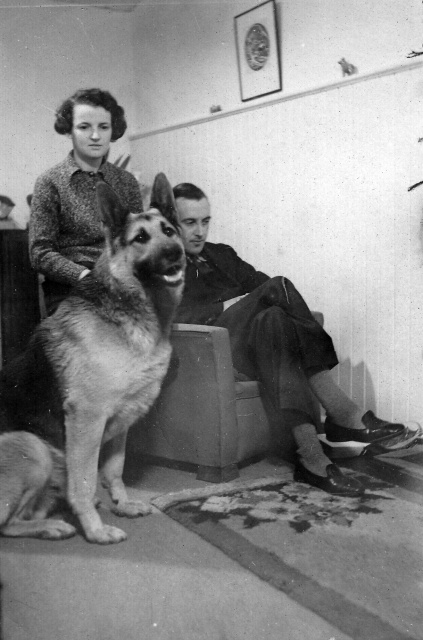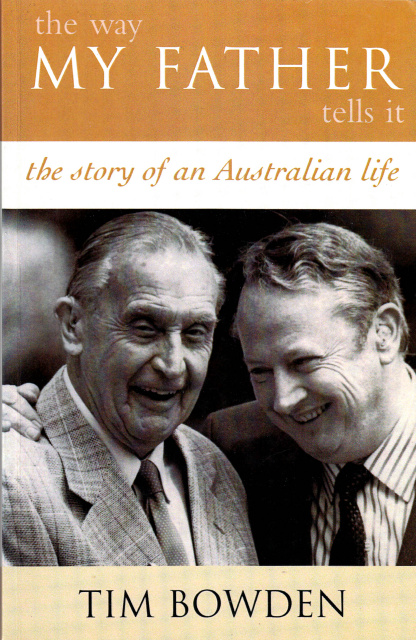In this fourth part of his Musings on the Art of Oral History, Australian broadcaster Tim Bowden discusses the recording and editing of his father's autobiography The Way My Father Tells It.
Telling it like it was...
By Tim Bowden
One of the traps of autobiography is a tendency to gild the lily, particularly when famous people – ‘tall poppies’ if you like – are concerned. All too often they use this opportunity as a platform for self-aggrandisement, sanitised of all unpleasant happenings or personal mistakes.
It never occurred to my father, John Bowden, that anyone other than family would be interested in reading about his life. And his self-deprecating humour came to the fore, as I knew it would.

In the beginning my father had asked me whether he had to keep any constraints on what he said. What about libel – or matters that might cause family hurt? I responded, ‘Trust me father.’ I suggested that he NOT impose any self-censorship, that he speak absolutely frankly, and we would consider whether or not to keep all the material on record later.
Being an autobiography, the final decision would be his. I can think of only one or two occasions when we actually pulled back from what was said, and they were family matters not of great general interest.
Actually Father had rather a salty turn of phrase, and although he was a kindly man, generally well disposed towards other members of the human race, there were certain individuals in his life not remembered fondly.
When my sister, Lisa, read the galleys of the book, she was mildly concerned that John had called a one-time pillar of the Tasmanian establishment – one Henry Allport – a pompous old prick.
More concerned for John than for propriety, she asked me if it was all right to have him quoted in that way. Happily, even in the minefield of Australian libel and defamation laws, you can rarely defame the dead. The query was really about the appropriateness of the language. I put this to Father.
'Well he was a pompous old prick', said Father. The sentence stayed unchanged.
Almost everyone can tell a good story
One of the great strengths of oral history is that it enables ordinary people to go on the record in a way that would never happen if we had to rely on people writing their stories down. Not many people write stylishly, instinctively, and well. Yet almost everyone can tell a good story. With few houses these days being without the ubiquitous tape (now digital) recorder, there exists the means to record anecdote and memory.
I strongly urge as many people as possible to do this. I think this technique works best for ‘ordinary’ people, although I would argue that my father was an extraordinary human being in ways even he did not appreciate.
After we finished the manuscript of The Way My Father Tells It, Dr Hank Nelson, who was an historian at the Australian National University, pointed out some – from my point of view – unconscious by-products of John's narrative.
Hank said: 'Although this is about an urban Australian family, the Bowdens lived close to the farming frontier, and often crossed it. John's story demonstrates that for many Australian suburban families before 1940, there was no sharp barrier between city and the bush. That is a false distinction. The Bowdens were as familiar with hand-milking and chook-feeding as they were with Argyle St.'
The book is published…

The Way My Father Tells It was recorded over quite a long period, from 1983 to 1989. When we ended in 1989, his last words were, ‘I live on in my house and I hope I can continue to live in my house until such time as they lead me or carry me away’.
The Way My Father Tells It – The Story of an Australian Life, was published in 1989 and, to father’s astonishment, did very well: eventually after two hardback editions, achieving seven editions in all.
As he approached his ninetieth birthday, he was strangely ambivalent, and was not keen to reach that notable milestone. There were some obvious concerns – at that age your contemporaries and old friends are thin on the ground.
But my father was most conscious of the fact that unlike your eighties, where, with luck, it is possible to foresee a reasonably active future, at ninety the chances of that, and continuing good health, are limited.
Things have to wear out eventually! In other words, the development he dreaded (as we all do) was to not have control of his own life. However, having notched up ninety years, we had a good family party and he became quite cheerful about it.
* * *
In Tim Bowden’s final post in this short series on oral history recording, John Bowden adds to his narrative eight years on from the first edition of his memoir, and reflects on what it is like to be really old.
Tim Bowden’s website is www.timbowden.com.au, where copies of his available books can be ordered.
Photo credits:
Peg and John Bowden with Thor, living in their rented two-room cottage in the grounds of the stately Hobart house Runymede, 1936: courtesy Tim Bowden.
Cover of The Way My Father Tells It: courtesy Tim Bowden.
